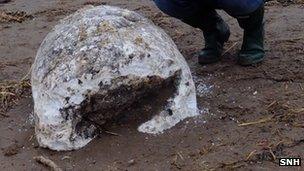WWII lard washes up on beach at St Cyrus nature reserve
- Published

SNH said the World War II lard still smelled fresh
Storms over the east coast have resulted in several unusual relics from World War II washing up on a beach in north east Scotland.
Staff at St Cyrus nature reserve said four large, barrel-shaped pieces of lard have appeared on the shore.
The fat is believed to have escaped from the wreck of a merchant vessel that was bombed in WW II.
Scottish Natural Heritage said the lard was still a brilliant white and smelled "good enough to have a fry up with."
The lard would have originally been stored in wooden barrels, which have long since rotted away.
Repeat sightings
It is not the first time that WWII supplies have washed ashore at the beach near Montrose.
Angus McHardy, a local resident and retired fisherman, said he remembers similar events in the in early 1940s.
"I'd never seen anything like it," he said. "There was quite a lot washed up at St Cyrus and beyond, not quite to Montrose.
"Some barrels were complete and others were just lumps. People collected it. My grandma boiled it up to get the sand out. It was great because we couldn't get fat during the war.
"I used to see the convoys for the merchant ships on my way home from school. The Germans attacked the convoys at the same time every night."
Broken shipwreck
He added: "After a storm in the late 60s or early 70s, the lard came up on-shore again. The seagulls thought it was a bonanza."
Therese Alampo, St Cyrus reserve manager, said: "The depth of the swell during the storms we had over the holidays must have broke apart the shipwreck some more and caused the lard to escape.
"It's given us some interesting sights recently on the reserve: I'm sure there have been people wondering what on earth has washed up on the beach.
"The lard was covered in the largest barnacles I've ever seen. Animals, including my dog, have certainly enjoyed the lard, and it still looks and smells good enough to have a fry up with."
- Published11 January 2013
- Published9 September 2011